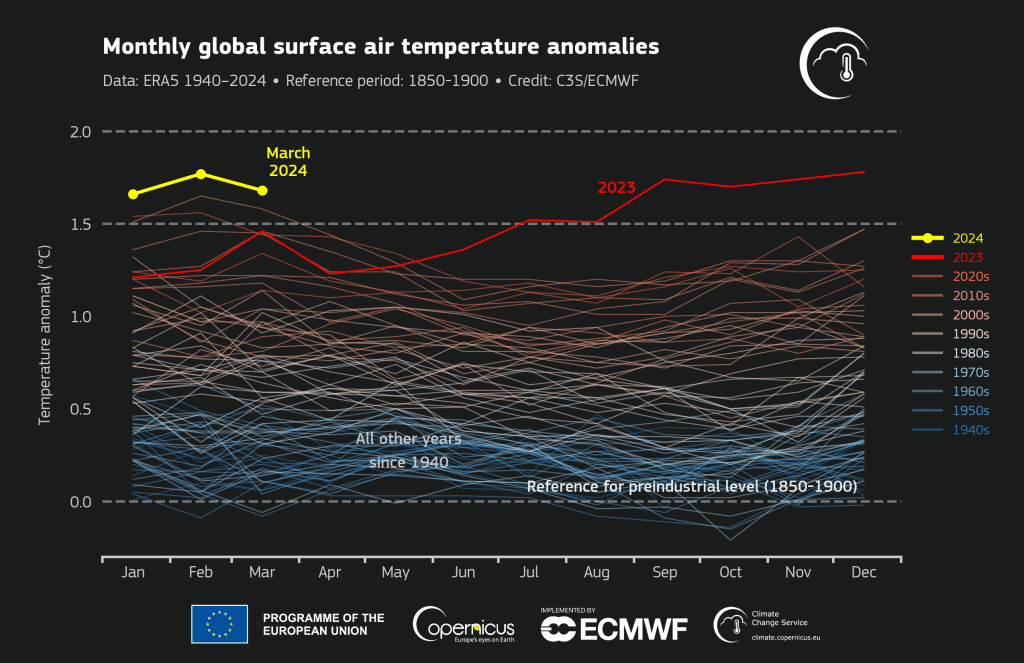Climate change is disproportionately affecting Asia. The continent was hit by a total of 79 water hazard-related disasters in 2023, which resulted in more than 2,000 fatalities and directly affected 9 million people.
—
Climate change is accelerating in Asia, exacerbating the frequency and severity of extreme weather events that profoundly affect societies, economies, and human lives.
This is the grim picture drawn in the World Meteorological Organization’s (WMO) annual State of the Climate in Asia report published Tuesday.
“The report’s conclusions are sobering. Many countries in the region experienced their hottest year on record in 2023, along with a barrage of extreme conditions, from droughts and heatwaves to floods and storms,” said Celeste Saulo, WMO Secretary-General.
Scorching Heat
According to the report, temperatures in Asia were 0.91C above the 1991-2020 reference period last year, the second-highest on record. 2023 was also Japan and Kazakhstan’s warmest year.
A historic heatwave swept across the continent in April and May, bringing all-time high temperatures to Vietnam, Laos, and Thailand. While a period of intense heat is not uncommon before the rainy season kicks in, the intensity of last year’s heatwave, which shattered all previous records, was unprecedented. China also battled scorching heat over the summer, with the mercury in the capital Beijing surpassing 40C (104F) for weeks and even reaching 52.2C in the northwest province of Xinjiang.
In 2023, a marine heatwave pushed sea surface temperatures in the Arctic Ocean to a record high. According to the report, regions such as the Arabian Sea, the southern Kara Sea, and the southeastern Laptev Sea are witnessing sea surface warming at a rate more than three times faster than the global average.
Natural Disasters
The WMO report found that nearly half of all 984,263 climate and natural disaster-related deaths over the past five decades occurred in Asia, with tropical cyclones claiming the highest number of lives. In 2023 alone, Asia saw a total of 79 water hazard-related disasters, which resulted in more than 2,000 fatalities and directly affected 9 million people.
An analysis by Zurich-based reinsurance company Swiss Re’s published in February revealed that the Philippines and the US pay the highest annual price from climate change-driven extreme weather events in relation to their gross domestic product (GDP). The two countries face annual economic losses of US$12 billion and $97 billion – or 3% and 0.38% of their GDP equivalent – respectively, from the combination of floods, tropical cyclones (hurricanes and typhoons), and severe thunderstorms.
According to the WMO, strong early warning and disaster risk reduction systems are among the climate mitigation strategies the continent needs to save lives and prevent future economic, social, and health crises exacerbated by climate change.
“Early warning and better preparedness saved thousands of lives,” said Armida Salsiah Alisjahbana, Executive Secretary of the UN Economic and Social Commission for Asia and the Pacific (ESCAP), which was also behind the report.
“A critical gap in the early warning information chain lies in knowledge and understanding of disaster risk. Addressing this gap is fundamental for effective multi-hazard early warning systems and therefore is a key determinant of the implementation of the Global Executive Action Plan on Early Warnings for All in Asia and the Pacific,” she said.
Lower Rainfall, Deadly Floods
Meanwhile, parts of Turkmenistan, Uzbekistan, Kazakhstan, Afghanistan, Pakistan, India, Bangladesh, Myanmar, and China experienced below-average precipitation. China’s southwestern provinces of Yunnan, Sichuan, and Guizhou suffered a major, prolonged drought amid lower-than-average precipitation nearly every month of the year.
Despite overall lower rainfall rates, parts of Asia witnessed deadly extreme events, over 80% of which were linked to floods and storms, according to the report.
These included floods and storms across India, Pakistan, and Nepal in June and July, which claimed at least 599 lives, and floods triggered by heavy monsoon rainfall in South Korea, which resulted in at least 40 fatalities. In September, Hong Kong was battered by the heaviest hourly rainfall in at least 140 years. While no casualties were reported, the city was brought to a standstill. It came just a week after Super Typhoon Saola paralysed the city, prompting authorities to issue Hurricane Signal No. 10 – the city’s highest storm signal – for the first time since 2018.

Melting Glaciers and Sea Level Rise
Record-breaking temperatures and dry conditions accelerated the melting of 20 out of 22 glaciers in central-south Asia and particularly in the Eastern Himalayas and the Tian Shan.
A 2023 study found that 68% of the world’s glaciers are set to disappear at the current global warming rate, with at least half of the loss taking place in the next 30 years. The melting of glaciers, ice sheets, and ice caps around the world is contributing to sea level rise, particularly in Asia, where rates were higher than the global mean over the 1993-2023 period.
More on the topic: Melting Glaciers in Pakistan: A Call to Action for the G20 Summit to Address the Situation
Not Just Asia
The past nine years have been the hottest on record, with 2023 topping the ranking. Last year’s record-breaking temperatures can be partly attributed to the return of El Niño, a weather pattern associated with the unusual warming of surface waters in the eastern equatorial Pacific Ocean. However, despite scientists confirming the gradual weakening of the pattern in recent weeks, the trend has continued well into the new year, with this past winter as a whole setting new high-temperature marks and March 2024 marking the 10th consecutive hottest month on record, both in terms of air and sea surface temperature.

The report comes hot on the heels of the publication of the annual State of the Climate in Europe published by WMO in collaboration with the EU’s leading Earth Observation programme Copernicus, which unveiled a similar grim picture of the accelerating climate crisis in the continent.
This story is funded by readers like you
Our non-profit newsroom provides climate coverage free of charge and advertising. Your one-off or monthly donations play a crucial role in supporting our operations, expanding our reach, and maintaining our editorial independence.
About EO | Mission Statement | Impact & Reach | Write for us


















